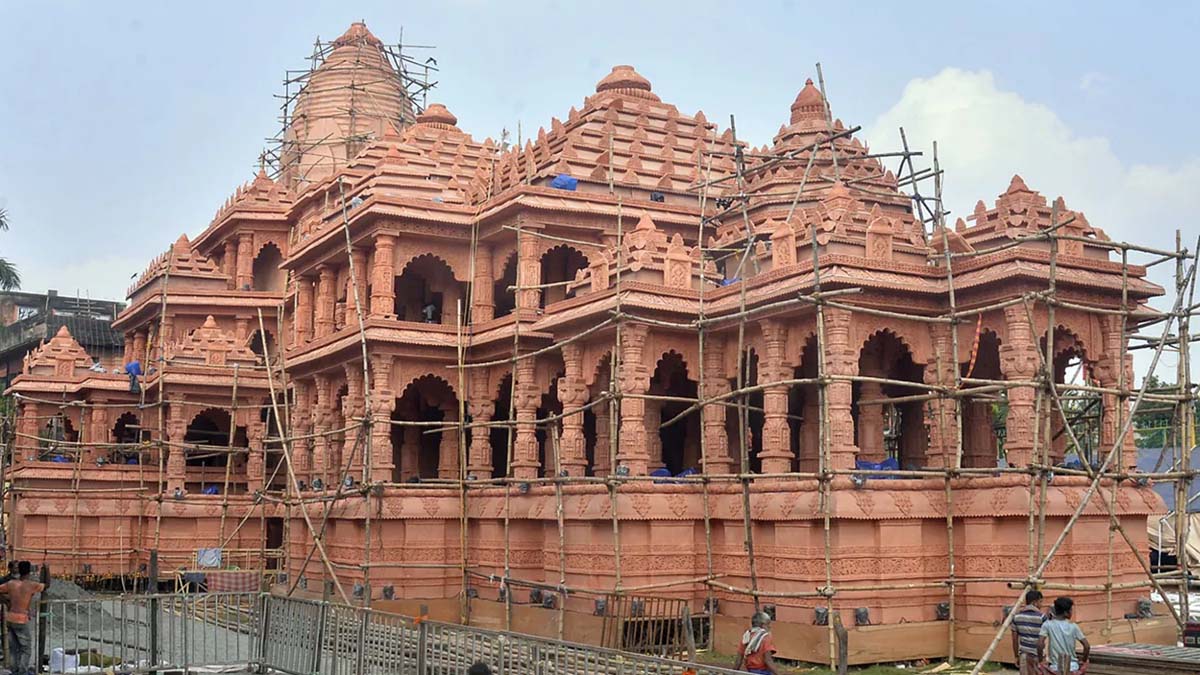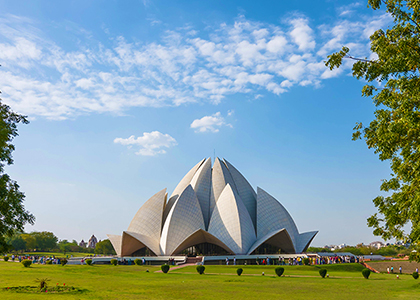
Shri Ram Mandir, Ayodhya
As the name suggests the Hindu temple of Lord Ram is located at his Janmabhoomi(birthplace)-Ayodhya, Uttar Pradesh. The temple is located at the former site of Babri Masjid which was built in the 16th Century. In 1949, the idols of Rama and Sita were placed in the mosque before it was demolished in 1992. ASI had proved in the court that the remaining underneath the area was non-Islamic so the land was assigned for the temple. On 5th August 2020, Prime Minister Narendra Modi did the bhumi puja and henceforth the construction of Shri Ram mandir started.
The consecration ceremony (Pran Pratishtha) of the 51-inch-long Shri Ram Lalla is scheduled for 22nd January 2024 at 12.20 p.m. It’s the third-largest Hindu shrine in the world. The temple will be open for pilgrims on 24th January but final construction is supposed to be finished by 24th February 2024. The temple will reflect the spiritual and cultural heritage of India.
Architecture, Infrastructure, and main features
The construction company is Larsen and Toubro(L&T) and the project management company for Shri Ram Mandir is Tata Consulting Engineers Limited (TCEL). The Mandir has a length of 380 feet, a height of 161 feet, and a width of 250 feet. The temple is built near the holy river Sarayu, Ayodhya, and spread across 2.77 acres of land. The temple is built in traditional Nagar architectural style. There are two types mainly used for constructing the temples, this is one of them. It’s a three-storied Earthquake-resistant building with a height of 20 feet.

Ram Darbar will be on the first floor. The temple will have 44 gates and 18 crafted doors out of which 14 are crafted with Gold. A total of 392 pillars are present. There are three different paths: Ram, Ram Janmbhoomi, and Bhakti. The deity of Shri Ram Lalla will be in the main sanctum. Shri Ram Mandir comprises five Mandapas: Nritya Mandapa, Rang Mandapa, Sabha Mandapa, Prarthana Mandapa, and Kirtan Mandapa. Many other temples will be built for Hindu Deities’. Special bricks are being used with “Sri Ram” written on them for construction just like they were used in Ram Setu. Shaligram rock from Nepal is specifically bought for carving the idol of Shri Ram as it symbolizes Lord Vishnu. The throne for the Ram Mandir’s Sanctrum is very impressive with eight feet in height, three feet long and four feet wide.
Four temples will be in the corners of the periphery dedicated to Suryadevta, Lord Ganesh, Mother Bhagvati, and Lord Shiva. In the northern arm, Goddess Annapoorna, and the Southern arm, Hanuman ji temples will be there. The temple comprises Sita Koop also. A few pictures of the night are also released and the temple looks beautiful. Prime Minister Narendra Modi has requested all to light up Diyas on 22nd January to mark a remarkable day in the history of this temple.
.jpg)
How to reach Ram Mandir, Ayodhya
The nearest Airport is the newly built Maharishi Valmiki International Airport in Ayodhya. Prime Minister Narendra Modi inaugurated the Ayodhya airport on 30th December 2023. Ayodhya has a good railway network so many direct trains from various cities are available. Two more airports from where one can easily travel are Varanasi and Faizabad as they have more connectivity across India as of now.
Ayodhya Junction and Faizabad Junction are the nearest to the temple. Similarly, many buses also run on this route. So, whichever mode of transport is comfortable from any city, one can take that. Also, many taxis are easily available in the city for all the travel. Vande Bharat Express will soon start connecting two important temples in Uttar Pradesh- Janmabhoomi and Gorakhnath temple whereas Delhi to Ayodhya Vande Bharat Train has already started. If you are also a Ram devotee and want to visit Ayodhya, Visit Ayodhya and fee the grace of Ram Janmbhoomi.
Know More: For Delhi to Ayodhya Tour, book tempo traveller on rent
Rituals to be performed at Ram Mandir in the upcoming week
Week-long rituals are to be performed starting from 16th January until 22nd January. The temple has released the details of the events:
16th January: Temple Trust has appointed a host who will perform the Atonement ceremony followed by a Dashvidh bath. It will be done at the banks of river Sarayu which includes Godan and Vishnu pooja.
17th January: The idol of Ram Lalla will be taken in procession and holy water of river Sarayu will be taken in Kalash.
18th January: Several pooja like Ganesh pooja, Varun pooja, Brahmin Varan, Matrika puja, Ambika puja and Vastu Puja will take place.
19th January: On this day Hawan will be followed by Navgrah Sthapna and Agni Sthapana.
20th January: On the fifth day, the sanctum sanctorum will be washed by the Holy water of river Sarayu. Vastushanti and Annadhivas will be done too.
21st January: The ritual of Shayadhivas will be performed a day before the final event. Deity of Shri Ram Lalla will be given a divine bath of 125 urns.
22nd January: On this final day, the deity of Shri Lord Ram (Ram Lalla) will be worshipped and consecration will be done in Mrigashira Nakshatra in the afternoon around 12.20 p.m.

Many prestigious guests are invited to the event numbering 10000-15000. Prime Minister Narendra Modi, Baba Ramdev, Amitabh Bachchan, Sachin Tendulkar, Virat Kohli, Ratan Tata, Mukesh Ambani and many more are invited on this day to be a part of this remarkable event of the temple. Shankaracharya of Dwarka Peeth and Srinegri Peeth are asking many followers to stand by the ceremony, light up diyas, and participate.
One lakh Tirupati Laddus will be distributed to the devotees attending the Ram Mandir event. Proper surveillance will be there and tight security as many VVIPs will attend the ceremony. The temple has the capacity of gathering around 50000-70000 people in a day. It is expected that lakhs of people will visit as soon as it is open for all.
Shri Ram Janmabhoomi Teerth Kshetra
PM Modi announced this Trust on 5th February 2020 for the management and construction of the Ram Mandir. It has 15 members out of which 12 were directly announced by the Government of India and rest three were added eventually. Mahant Nritya Gopal Das is the chairman of this Trust. Anyone can donate to the Trust from or outside India. One can attend the Mangal Aarti also but you need to book before. Temple Darshan timings are 7:00 a.m. to 11.30 a.m. and 2:00 p.m. to 7:00 p.m. All the details are mentioned on the website: https://srjbtkshetra.org/
Significance of Tourism in Ayodhya
Spiritual Tourism in the city of Ayodhya has seen a massive hike due to the construction of the Ram Mandir Temple. This sector has given thousands of jobs to the people of the city. Thus, the economy of the city has increased. It will be the spiritual city of India gradually. A spike of 8.37% can be seen annually since the announcement of the Ram Mandir. The city is redefining itself with a new era of tourism.
Construction of the temple has also provided thousands of jobs to the unemployed. New businesses and more opportunities for work are being created. One can also buy souvenirs from Ayodhya like idols of Shri Ram, Sita Mata, Shri Laxman, Shri Ram Mandir Statue or sculptures of the temple and religious text quotes. Hotels are more expensive than normal times and many of them are completely booked. It’s a boon for the travel industry as well. Whenever one visits Uttar Pradesh, Ayodhya can be covered mainly with Varanasi. A spiritual tour for all age groups will help one learn about the Legacy of Shri Ram and Hinduism.
Where can you go in Ayodhya?
Being a holy city for Hindus, Ayodhya will play a vital role in tourism after Ram Mandir's inauguration. You can book Ayodhya tour package to explore the city with the best travel plan. Few places in Ayodhya, you can check out if you are planning to visit here:
1. Sita ki Rasoi: It used to be the kitchen of Sita Mata (wife of Sri Ram).
2. Sri Nageshwar Nath Mandir Ayodhya Trust: A beautiful temple managed by Ayodhya Trust and known for its architecture. It is devoted to Lord Shiva.
3. Hanuman Garhi Mandir: It is dedicated to Lord Hanuman and rightly said that before visiting Sri Ram Mandir, one should take blessings from this temple. This is just 1 km away from Ram Janmabhoomi.
4. Dashrath Mahal: The Palace of Dashrath is just 50 meters from Hanuman Garhi.
5. Swarg Dwar: One can take a holy dip into the river Sarayu, water is very clean.

Illuminated Ayodhya
This Pilgrimage offers a blend of beautiful sculptures, spiritual knowledge, and richness in culture. The temple narrates India’s collective heritage. The intricate work done on each of its bricks is just splendid. Ram Mandir is not just for the pilgrims but also for historians, researchers, seekers, and the curious. It is full of rich culture, knowledge, and accomplishment. In the history of India, the construction of this temple is a landmark event to signify integrity, morality, justice, and truth. The temple is a dedication to all Hindus and their soul love and devotion to Lord Ram. The Ram Mandir is not just a temple but an amalgam of faith, cultural heritage, and unity. The temple is the epitome of respect, hope, inspiration, and power of the human spirit.
The original design was devised in 1988 by the Sompura family in Ahmedabad. Their 15 generations have constructed over 100 temples including the Somnath Temple. The main architect of the temple was Chandrakant Sompura assisted by his two sons in 2020.
The temple has become a catalyst in Ayodhya’s economic growth. Several new crafts and businesses have sprouted near the temple giving local artisans a chance to develop and giving tourists native handcrafts.
Ayodhya welcomes all with open hearts whether you want to travel in the normal season or during festivals such as Deepawali or Ram Navami. You will be astonished by Diwali in Ayodhya. The journey will be worthwhile once you visit the Ram Mandir and are astonished by its beautiful architecture. One will leave with a pure soul, happiness, and calmness of mind.
Latest Developments in Ayodhya
• Jatayu Cruise Ride Service at Ayodhya
• New hotels and restaurants opening in Ayodhya
• Temple Museum in Ayodhya
• Ayodhya Helicopter Tour
• To witness the grand ceremony of Pran Pratishta, large floating screens installed at Chaudhary Charan Singh Ghat















